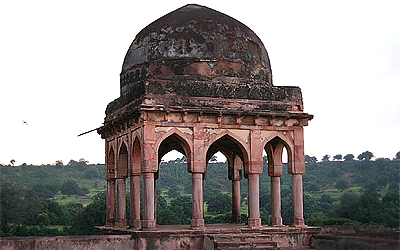 Mandavgad or Mandu is a ruined city located in the Dhar district in the Malwa region of western Madhya Pradesh state. It is situated at a distance of about 90 km from the Indore city and 35 km from Dhar. Mandu served as the sub division of the Tarangagadh or Taranga kingdom in the 11th century. The city is situated at an elevation of 2000 feet above the sea level. Mandu is a celebration in stone of life and joy and of the love of the poet-prince Baz Bahadur for his beautiful wife, Rani Rupmati. An ancient town of the medieval age, it is one of India`s most historical monuments set against the backdrop of the Vindhyas.
Mandavgad or Mandu is a ruined city located in the Dhar district in the Malwa region of western Madhya Pradesh state. It is situated at a distance of about 90 km from the Indore city and 35 km from Dhar. Mandu served as the sub division of the Tarangagadh or Taranga kingdom in the 11th century. The city is situated at an elevation of 2000 feet above the sea level. Mandu is a celebration in stone of life and joy and of the love of the poet-prince Baz Bahadur for his beautiful wife, Rani Rupmati. An ancient town of the medieval age, it is one of India`s most historical monuments set against the backdrop of the Vindhyas.
History of Mandu
Mandu was earlier known by the name of "Shadiabad" meaning the city of happiness. It was named by the then ruler Ala-ud-din Khilji. Mandu city is situated at an elevation of 633 metres (2079 feet) and extends for 13 km (8 miles) along the crest of the Vindhya Range, overlooking the plateau of Malwa to the north and the valley of the Narmada River to the south. These acted as natural defences and Mandu was originally the fort-capital of Rajput Parmara rulers of Malwa. Towards the end of the 11th century, it came under the Taranga kingdom.
Tourist Spots in Mandu
Mandu has been a famous tourist place that attracts many visitors here.
The Darwazas
The 45 km parapet of walls that encompasses Mandu is punctuated by 12 gateways. The most notable of these is Delhi Darwaza that serves as the main entrance to the fortress city. The tourists approach through a series of gateways well fortified with walled enclosures and strengthened by bastions such as the Alamgir and Bhangi Darwaza, through which the present road passes. Rampol Darwaza, Jehangir Gate and Tarapur Gate are some of the other main gateways.
Jahaz Mehal or Ship Palace
Jahaz Mehal is a 120 mt long "ship palace" situated between the two artificial lakes, Munj Talao and Kapur Talao. It is an elegant two storied palace built by Ghiyas-ud-din-Khilji. It is so named as it appears as a ship floating in water.
Hindola Mahal
Hindola Mahal derives its name of "swinging palace" from its sloping sidewalls. Superb and innovative techniques adorn the monument. To the West of Hindola Mahal there are several unidentified buildings which still bear traces of their past grandeur. Amidst these is an elaborately constructed well called Champa Baoli which is connected with underground vaulted rooms where arrangements for cold and hot water were made. Other places of interest in this enclave are Dilawar Khan`s Mosque, the Nahar Jharokha (tiger balcony), Taveli Mahal, the two large wells called the Ujali (bright) and Andheri (dark) Baolis and Gada Shah`s Shop and House, all worth a visit.
Hoshang Shah`s Tomb
This monument stands as one of the exquisite examples of Afghan architecture. It is India`s first marble structure. Its exclusive features are the beautifully proportioned dome, intricate marble lattice work and porticoed courts and towers.
Jami Masjid
The structure of Jama Masjid has been inspired by the great mosque of Damascus. This humongous structure is popular for its striking beauty and simplicity. It is adorned with large courtyards and grand entrances.
Rewa Kund
A reservoir constructed by Baz Bahadur for the purpose of supplying water to Rani Rupmati`s Pavilion. The reservoir is situated below the pavilion and today, the pool is revered as a sacred spot.
Rupmati`s Pavilion
Rupmati Pavalion is located on the lofty hill to the south beyond the palace of Baz Bahadur. A closer examination of the building shows that it had under gone different phases of construction in different periods spread over 15th to 17th centuries AD.
Baz Bahadur`s Palace
Baz Bahadur`s Palace is one of the most attractive sights in Mandu. Adorned with scenic beauty this palace still narrates the love story of Rani Rupmati and Baz Bahadur. It is situated below Roopmati`s Pavilion and can be seen from the pavilion.



















